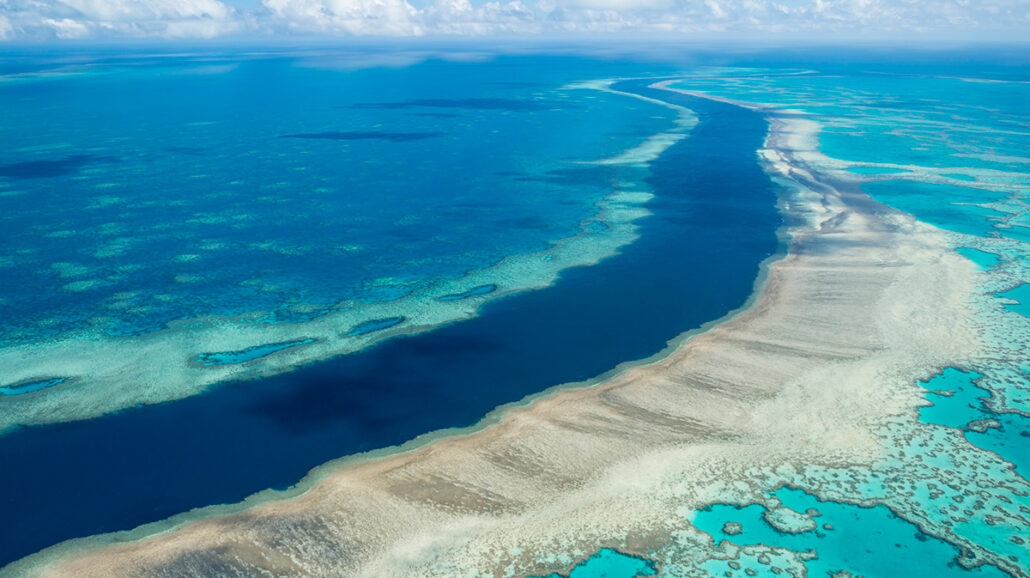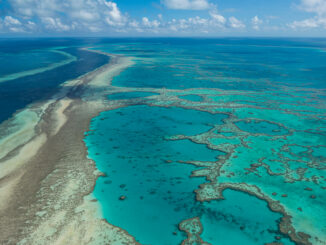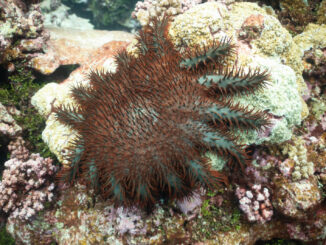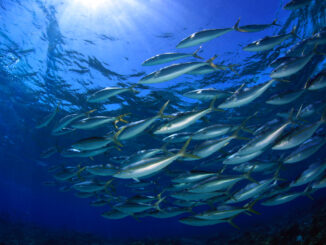
The world’s largest reef system is suffering from a massive coral bleaching event over an “extensive” area, Australian authorities are now reporting.
Ocean scientists and conservationists say they are closely monitoring a coral bleaching outbreak hitting large sections of Australia’s Great Barrier Reef Marine Park.
The authorities said aerial inspections of most of the reef encountered evidence of coral bleaching in nearly every portion surveyed. It will take time to uncover the full extent of the bleaching event given that the Great Barrier Reef stretches for more than 2,300 kilometers and aerial observations can only detect coral bleaching occurring in shallow waters.
According to the Great Barrier Reef Marine Park Authority’s latest Reef Health Update, abnormally high ocean temperatures are to blame for this latest episode. The Authority says two-thirds of the GBR Marine Park has been surveyed by airplane so far in an effort to capture the extent of the bleaching.
“Aerial surveys of the Reef have revealed prevalent shallow water coral bleaching on most surveyed reefs and results are consistent with patterns of heat stress that has built up over summer,” the update says.
The Authority’s reef health director Mark Read said in a statement that the damage to the GBR’s coral colonies will likely become extensive this year. The impact of bleaching will worsen should the unusually high ocean temperatures persist for an extended period.
“Aerial surveys have been completed on over 300 inshore, mid-shelf, and offshore reefs, from Cape Melville north of Cooktown to just north of Bundaberg” the GBR Marine Park Authority announced. “Further surveys will be undertaken pending favorable weather conditions.”
New promising recovery methods, but climate threat persists.
Coral bleaching occurs when abnormally high ocean water temperatures compel coral polyps, the animals that form hard reef skeletons, to expel the photosynthetic cyanobacteria that feed energy to the polyps and keep them alive. Eventually, the animals die and the hard calcium carbonate skeletons left behind turn white.
“In the reef communities surveyed, most coral cover displayed some level of bleaching with white and fluorescent colonies observed in shallow reef areas,” Read said.
Corals can recover from bleaching events, but entire systems will die if harmful ocean temperature conditions linger for too long.
Even as the Great Barrier Reef is struck with this latest bleaching episode, Australian scientists say they are paying close scrutiny to new research that suggests coral systems could be rehabilitated from damage relatively quickly.
In a newly published paper, scientists from the United Kingdom and Indonesia say they were able to fully restore a badly damaged Indonesian reef through transplanting reefs and other restoration techniques. That reef system had been devastated by fishermen using dynamite for fishing.
The paper claims that the complete revival of one reef targeted for the experiment occurred within four years.
Though the results appear promising, some reef health experts are cautioning against over-optimism.
Terry Hughes, a professor and director of the Australian Research Council’s Centre of Excellence for Coral Reef Studies, noted that a similar reef recovery experiment in Florida was thwarted last year by higher ocean temperatures. Hughes says global warming is to blame for that failure, and no amount of reef transplanting can overcome this.
“It’s delusional to think that coral restoration is a solution to the global destruction of reefs by anthropogenic climate change,” he said in an official response to the UK-Indonesia study. “Worse, it detracts attention away from the urgent imperative to reduce greenhouse gas emissions.”
Other experts are taking slightly more positive views.
Jen Matthews, a researcher at the University of Technology Sydney’s Future Reefs Program, said at a minimum the UK-Indonesia study shows that steps can be taken to “help buy time” for reefs threatened by global warming, including the GBR.
“This study provides compelling evidence of how coral transplantation can help to stabilize loose foundations, rebuild degraded reefs, and restore certain ecosystem functions,” Matthews said. “This helps to justify the current coral transplantation efforts conducted across Australia, but also the need for more restoration practices that build genetic diversity, and not just coral cover.”
Retired University of Melbourne biosciences professor Robert Day agreed that the UK-Indonesia study held out hope for reefs. However, Day called for more research on ways to effectively repair reefs damaged by climate-induced coral bleaching events.
“The study was not done on reefs damaged by climate change, and the measurements made could not predict ecosystem effects with much confidence, so we cannot be sure these results will apply to attempts to recover reefs damaged by climate change,” Day said in his reaction.
Coral bleaching investigation continues
The Great Barrier Reef Marine Park Authority said that the waters in the survey area are calm enough for the time being to facilitate effective aerial observations. Clear, calm waters are allowing investigators to visually assess the area extent of bleaching.
However, the authority says it will eventually send teams of divers to get a better look.
“Aerial surveys are an ideal tool to assess the spatial extent of bleaching, but we need to go under the water to understand more about the severity of bleaching and how deep the bleaching extends,” Australian Institute of Marine Science researcher Neal Cantin said.
The GBR Marine Park Authority says it will conduct overflights of more of the reef in the coming days. Officials there are expressing hopeful optimism. They say the Great Barrier Reef has proven to be remarkably resilient and capable of recovering from heat stress-induced coral bleaching and other threats, including mass outbreaks of crown-of-thorns starfish and violent weather.
“Danger” still lurks
One of the world’s most popular tourist destinations, the Great Barrier Reef Marine Park is a natural UNESCO World Heritage Site. However, officials at UNESCO have threatened to downgrade its status due to increasingly common bleaching events such as the one underway now and the ongoing threat of climate change.
UNESCO says GBR is facing grave risks from global warming, in particular, mass bleaching events like this one and severe cyclones that are feared to be becoming more frequent.
The world-famous Great Barrier Reef has been hit by multiple coral bleaching events attributed to global warming.
The GBR Marine Park came very close to being designated a World Heritage Site “in danger” last year, but the Australian government convinced UNESCO to avoid doing so for the time being, fearing that designation could hurt tourism to the reef.
©2025 Public Parks
Park Info
Park Name:
Great Barrier Reef Marine Park
Location:
Australia
More information:



